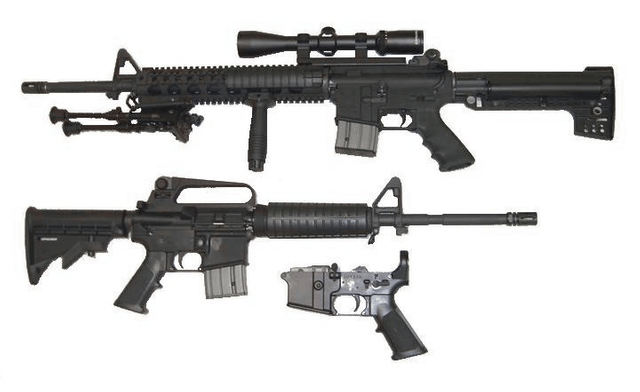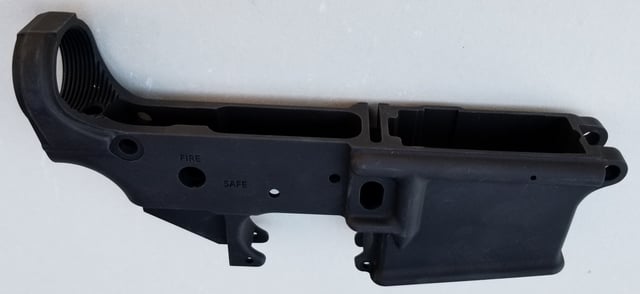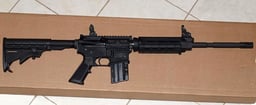Ar-15

Ar-15
An AR-15 style rifle is a lightweight semi-automatic rifle based on the ArmaLite AR-15 design. ArmaLite sold the patent and trademarks to Colt's Manufacturing Company in 1959. After Colt's patents expired in 1977, Colt retained the trademark and is the exclusive owner of "AR-15" designation.[1] The Public Safety and Recreational Firearms Use Protection Act restricted the Colt AR-15 and derivatives from 1994 to 2004, although it did not affect rifles with fewer features.[2][3]
After the term modern sporting rifles was coined in 2009 by the US National Shooting Sports Foundation, a firearms industry trade association, it was quickly adopted by the trade association and some manufacturers.[4][5] An expanded marketplace emerged with many manufacturers producing their own version of the AR-15 design for commercial sale.
In the 2010s, AR-15 style rifles have become one of the "most beloved and most vilified rifles" in the United States, according to the New York Times.[6] The rifle has been promoted as "America's rifle" by the National Rifle Association. Steadily increasing popularity in part is due to "the amount of attention through politics and media that is devoted to banning or restricting AR pattern rifles".[7][8][9][10] They have been used in mass shootings in the United States.[6]
Terminology

1973 Colt AR-15 SP1 rifle with 'slab side' lower receiver (lacking raised boss around magazine release button) and original Colt 20-round box magazine
In 1956, ArmaLite designed a lightweight selective fire rifle for military use and designated it the ArmaLite Rifle model 15, or AR-15.[11][12] Due to financial problems and limitations in terms of manpower and production capacity, ArmaLite sold the design and the AR-15 trademark along with the ArmaLite AR-10 to Colt's Manufacturing Company in 1959.[13] In 1964, Colt began selling its own version with an improved semi-automatic design known as the Colt AR-15.[14] After Colt's patents expired in 1977, an active marketplace emerged for other manufacturers to produce and sell their own semi-automatic AR-15 style rifles.[1] Some versions of the AR-15 were classified as "assault weapons" and banned under the Public Safety and Recreational Firearms Use Protection Act in 1994. This act expired in 2004.[2][15]
In 2009, the term "modern sporting rifle" was coined by the National Shooting Sports Foundation for its survey that year as a marketing term used by the firearms industry to describe modular semi-automatic rifles including AR-15s.[16][4][17][18] Today, nearly every major firearm manufacturer produces its own generic AR-15 style rifle.[19][17] As Colt continues to own and use the AR-15 trademark for its line of AR-15 variants, other manufacturers must use their own model numbers and names to market their AR-15 style rifles for commercial sale.[20]
Modularity

A stripped lower receiver, one that is lacking the additional parts included in a completed lower receiver, is the only part of an AR-15 style rifle that needs to be transferred through a federally licensed firearms dealer under United States federal law.[29]
While most earlier breech-loading rifles had a single receiver housing both the trigger and reloading mechanism, an innovative feature of the AR-15 was modular construction to simplify substitution of parts and avoid need for arsenal facilities for most repairs of malfunctioning military rifles.[21] A distinctive two-part receiver is used by both military and sporting AR-15 style rifles. As civilian ownership of AR-15 style rifles became sufficient to create a market for improvements, numerous manufacturers began producing one or more "improved" modules, assemblies, or parts with features not found on factory rifles; and individuals with average mechanical aptitude can often substitute these pieces for original equipment. Due to the vast assortment of aftermarket parts and accessories available, AR-15 style rifles have also been referred to as "the Swiss Army knife of rifles,"[22] "Barbie Dolls for Guys,"[23][24] or "LEGOs" (sic) for adults.[25][26][27] These more or less interchangeable modules are a defining characteristic of AR-15 style rifles.[28]
The lower receiver is the serial-numbered part legally defined as the firearm under United States law. A completed lower receiver is visually distinguished by the trigger guard ahead of the detachable pistol grip, and behind the magazine well capable of holding detachable magazines. The lower receiver holds the trigger assembly including the hammer, and is the attachment point for the buttstock. The lower receiver is attached to the upper receiver by two removable pins. Disassembly for cleaning or repair of malfunctions often requires removal of these pins. Removal of the rear take-down pin allows the receiver to be opened by rotation around the forward pivot pin as a hinge.[21]
The upper receiver contains the bolt carrier assembly, and is attached to the barrel assembly. Sights will be attached to the upper receiver or to the barrel assembly. A handguard usually encloses the barrel and a gas-operated reloading device using burnt powder gas vented from a hole (or port) in the barrel near the forward end of the handguard. The handguard is attached to the upper receiver and may also be attached to the barrel.[21]
The initial design included a tube to vent burnt powder gas back into the bolt carrier assembly where it expands in a variable volume chamber forcing the bolt open to eject the spent cartridge case. A buffer spring in the butt stock then pushes the bolt closed picking up a new cartridge from the magazine. This direct gas impingement (DGI) system has the disadvantage of venting un-burned smokeless powder residue into the receiver where it may ultimately accumulate in quantities causing malfunctions. A more recent alternative design has a metal operating rod pushing against the bolt carrier from a gas piston under the hand guard near the barrel port. This piston keeps the receiver cleaner by exhausting under the hand guard.[30] While both the DGI and piston systems produce semi-automatic fire, an alternative un-ported barrel assembly includes a sliding hand guard connected to a rod moving the bolt by a pump action and eliminating semi-automatic fire.[31]
Most rifles eject spent cartridges from the right side of the receiver away from right handed shooters who place the butt against the right shoulder while sighting with the right eye and using a finger of the right hand to pull the trigger.[32] Right-side ejection is a disadvantage for the third of the population whose left eye is dominant,[33] and for the tenth of the population who are left handed,[34] because holding these rifles against their left shoulder for maximum accuracy causes the rifle to eject hot spent cases toward the chest, neck or face of a left handed shooter.[35] The modular design of AR-15 style rifles has encouraged several manufacturers to offer specialized parts including leftward ejecting upper receivers for converting right handed AR-15 style rifles for left handed use.[36][37][38]
Some AR-15-style rifles have features limiting use of detachable magazines to comply with state regulations.[39][40] A few unusual versions are incapable of semi-automatic fire.[31][41] Nearly all versions of the civilian AR-15 have a pistol grip like the military versions, and some have folding or collapsible stocks like the M4 carbine which reduce the overall length of the rifle.
Comparison to military versions
The semi-automatic civilian AR-15 was introduced by Colt in 1963. The primary distinction between civilian semi-automatic rifles and military assault rifles is select fire. Military models were produced with firing modes, semi-automatic fire and either fully automatic fire mode or burst fire mode, in which the rifle fires several rounds in succession when the trigger is depressed. Most components are interchangeable between semi-auto and select fire rifles including magazines, sights, upper receiver, barrels and accessories.[42][43] The military M4 carbine typically uses a 14.5-inch (37 cm) barrel. Civilian rifles commonly have 16-inch (41 cm) or longer barrels to comply with the National Firearms Act.[44]
In order to prevent a civilian semi-automatic AR-15 from being readily converted for use with the select fire components, a number of features were changed. Parts changed include the lower receiver, bolt carrier, hammer, trigger, disconnector, and safety/mode selector. The semi-automatic bolt carrier has a longer lightening slot to prevent the bolt's engagement with an automatic sear. Due to a decrease in mass the buffer spring is heavier. On the select fire version, the hammer has an extra spur which interacts with the additional auto-sear that holds it back until the bolt carrier group is fully in battery, when automatic fire is selected.[45] Using a portion of the select fire parts in a semi-automatic rifle will not enable a select fire option (this requires a registered part with the ATF). Lower receivers that are select fire are identified by a pin hole above the safety/mode selection switch.[46][47][48][49] As designed by Colt the pins supporting the semi-auto trigger and hammer in the lower receiver are larger than those used in the military rifle to prevent interchangeability between semi-automatic and select fire components.[50]
Production and sales
The first version produced for commercial sale by Colt was the SP1 model AR-15 Sporter, in .223 Remington, with a 20-inch (51 cm) barrel and issued with five-round magazines.[14] Initial sales of the Colt AR-15 were slow, primarily due to its fixed sights and carry handle that made scopes difficult to mount and awkward to use.[51] Military development of the compact M4 carbine encouraged production of a 16-inch (41 cm) barreled civilian SP1 carbine with a collapsible buttstock beginning in 1977. These carbines have become popular for police use in confined urban spaces, and the collapsible buttstock compensates for the additional thickness of body armor. The shorter barrel reduced bullet velocity by about five percent, and bullet energy by about ten percent. The shorter barrel required moving the gas port closer to the chamber exposing the self-loading system to higher pressures and temperatures which increase stress on moving parts like the bolt lugs and extractor. Although Colt offered a heavier 20-inch barrel for improved accuracy beginning in 1986, increased barrel weight may impair ergonomic balance; so shorter barrels have dominated recent rifle production.[52]
In the 1990s, sales of AR-15 style rifles increased dramatically, partly as a result of the introduction of the flat top upper receiver (M4 variant) which allowed scopes and sighting devices to be easily mounted as well as new features such as free floating hand guards that increased accuracy.[51] While only a handful of companies were manufacturing these rifles in 1994, by the 21st century the number of AR-15 style rifles had more than doubled.[53] From 2000 to 2015, the number of manufacturers of AR-15 style variants and knock-offs increased from 29 to about 500.[54] AR-15 style rifles are now available in a wide range of configurations and calibers from a large number of manufacturers. These configurations range from standard full-sizes rifles with 20-inch (51 cm) barrels, to short carbine-length models with 16-inch (41 cm) barrels, adjustable length stocks and optical sights, to long range target models with 24-inch (61 cm) barrels, bipods and high-powered scopes.[55]
As of September 19, 2019, Colt Firearms has announced it is discontinuing production of the AR-15. The reasons given for taking the rifle out of production were low demand for Colt-made ARs and excessive production capacity for the rifle across the firearms industry.[56]
Estimates vary as to how many of the rifles are owned in the United States. The National Shooting Sports Foundation has estimated that approximately 5 million to 10 million AR-15 style rifles exist in the U.S. within the broader total of the 300 million firearms owned by Americans.[57]
Hunting
Some hunters prefer using AR-15 style rifles because of their versatility, accuracy, wide variety of available features, and wide variety of calibers(see below).[58] Collapsible stocks are convenient for hunters who pack their rifles into remote hunting locations or for length of pull adjustments to fit any sized hunter.[59] Construction with lightweight polymers and corrosion-resistant alloys makes these rifles preferred for hunting in moist environments with less concern about rusting or warping wood stocks. Positioning of the AR-15 safety is an improvement over traditional bolt action hunting rifles. Many states require hunters to use reduced-capacity magazines.[60] If a hunter misses with a first shot, the self-loading feature enables rapid follow-up shots against dangerous animals like feral pigs or rapidly moving animals like jackrabbits.[58] Hunters shooting larger game animals often use upper receivers and barrels adapted for larger cartridges or heavier bullets. Several states consider .22 caliber cartridges like the 5.56×45mm NATO inadequate to ensure a clean kill.[61][62][63]
Cartridge variations
Since the upper and lower receivers may be swapped between rifles, forensic firearm examination of bullets and spent cartridges may reveal distinguishing marks from the barrel and upper receiver group without identifying the lower receiver for which legal records may be available.[64] An individual may use several upper receiver groups with the same lower receiver. These upper receiver groups may have differing barrel lengths and sights, and may fire different cartridges. A hunter with a single lower receiver might have one upper receiver with a .223 Remington barrel and telescopic sight for varmint hunting in open country and another upper receiver with a .458 SOCOM barrel and iron sights for big-game hunting in brushy woodland. The dimensions of upper and lower receivers originally designed for the 5.56×45mm NATO cartridge impose an overall length limit and diameter limits when adapting modules for other cartridges included in this list of AR platform calibers.[65][55] The same magazine in the lower receiver group may hold differing numbers of different cartridges.[30]
Use in crime and mass shootings
A majority of firearm-related homicides in the United States involve the use of handguns.[66][67][68] According to a 2013 analysis by Mayors Against Illegal Guns, 14 out of 93 mass shootings involved high-capacity magazines or assault weapons.[69] Nevertheless, AR-15 style rifles have played a prominent role in many high-profile mass shootings in the United States[70] and have come to be widely characterized as the weapon of choice for perpetrators of these crimes.[71] AR-15s or similar rifles were the primary weapons used in around half of the 10 deadliest mass shootings in modern American history,[72][73] including the 2012 Sandy Hook Elementary School shooting, the 2015 San Bernardino attack,[6] the 2017 Las Vegas shooting,[74] the 2017 Sutherland Springs church shooting,[74] and the 2018 Stoneman Douglas High School shooting.[75] Gun expert Dean Hazen and mass murder researcher Dr. Pete Blair think that mass shooters' gun choices have less to do with the AR-15's specific characteristics but rather with familiarity and a copycat effect.[76][77]
Following the use of a Colt AR-15 rifle in the Port Arthur massacre, the worst single-person shooting incident in Australian history, the country enacted the National Firearms Agreement in 1996, restricting the private ownership of semi-automatic rifles with a capacity of more than 5 rounds (Category D[78]).[79][80][81] As a result of the Christchurch mosque shootings during Friday Prayer on 15 March 2019, the New Zealand government enacted a law to ban semi-automatic firearms, magazines, and parts that can be used to assemble prohibited firearms [82][83]
Partial list of models
Barrett REC7
Bushmaster XM-15
Carbon 15
Colt AR-15
Daniel Defense DDM4
DPMS Panther Arms Tactical Rifle
Heckler & Koch MR556
Lewis Machine & Tool Company CQB16
LWRC International IC series
Mossberg MMR Tactical
Olympic Arms K series
Palmetto State Armory
Patriot Ordnance Factory rifles and carbines
Remington R5 RGP
Rock River Arms LAR-15
Ruger SR-556
Savage Arms MSR-15
SIG Sauer SIG516
SIG Sauer SIGM400
Smith & Wesson M&P15
Stag Arms STAG-15
Taurus T4SA
Wilson Combat Tactical Rifle
Examples of AR-15 style rifles and carbines
See also
List of Colt AR-15 & M16 rifle variants, a list of Colt-made firearms based on the ArmaLite AR-15 design
List of most-produced firearms, comparison of relative production of modern firearms




